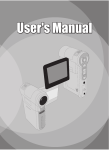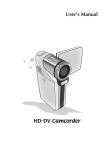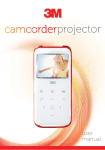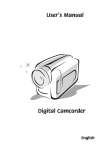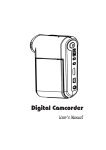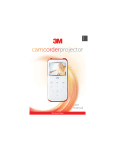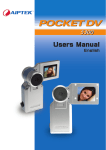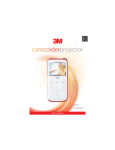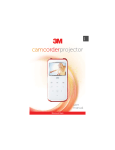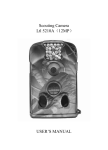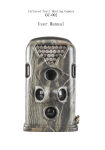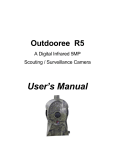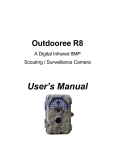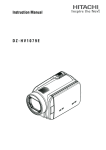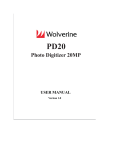Download User`s Manual
Transcript
User's Manual Safety Notice: 1. Do not drop, puncture or disassemble the camcorder; otherwise the warranty will be voided. 2. Avoid all contact with water, and dry hands before using. 3. Do not expose the camcorder to high temperature or leave it in direct sunlight. Doing so may damage the camcorder. 4. Use the camcorder with care. Avoid pressing hard on the camcorder body. 5. For your own safety, avoid using the camcorder when there is a storm or lightning. 6. Do not use batteries of different specifications. Doing so may lead to the potential for serious damage. 7. Remove the battery during long periods between usage, as a deteriorated battery may affect the functionality of the camcorder. 8. Remove the battery if it shows signs of leaking or distortion. 9. Use only the accessories supplied by the manufacturer. 10. Keep the camcorder out of the reach of infants. FCC Compliance Statement: This device complies with Part 15 of the FCC Rules. Operation is subjected to the following two conditions: (1) this device may not cause harmful interference, and (2) this device must accept any interference received, including interference that may cause undesired operation. This equipment has been tested and found to comply with limits for a Class B digital device, pursuant to Part 15 of the FCC rules. These limits are designed to provide reasonable protection against harmful interference in residential installations. This equipment generates, uses, and can radiate radio frequency energy, and if not installed and used in accordance with the instructions, may cause harmful interference to radio communications. However, there is no guarantee that interference will not occur in a particular installation. If this equipment does cause interference to radio or television equipment reception, which can be determined by turning the equipment off and on, the user is encouraged to try to correct the interference by one or more of the following measures: -Reorient or relocate the receiving antenna. -Move the equipment away from the receiver. -Plug the equipment into an outlet on a circuit different from that to which the receiver is connected. -Consult the dealer or an experienced radio/television technician for additional suggestions. You are cautioned that any change or modifications to the equipment not expressly approved by the party responsible for compliance could void Your authority to operate such equipment. Getting Started Knowing your camcorder parts Microphone Speaker Lens LED lights Flash strobe Battery cover Strap hook Bottom view Tripod socket SD/MMC card slot (inside the battery cover) Status LED (left) / Charging LED (right) Mode button Menu button LCD monitor Shutter button Previous button/ Fast backward button Zoom (in/out) button Play/Pause button Record button Next button/ Fast forward button Earphone connector Macro mode switch USB connector * AV connector * Flash switch OK key/ 4:3/16:9 display switch White balance switch Power button * inside the cover LED lights switch Installing the battery 1. Slide the battery cover open as indicated. 2. Place the accessory Li-Ion battery into the compartment. Note that the metallic contacts must be aligned with the contacts in the compartment. 3. After the battery is properly installed, replace the battery cover. Charging the battery Please charge the battery at least 4 hours for first time use. 1. Connect the cable. Connect one end of the supplied AC adapter to the USB port of the camcorder and the other end to a wall outlet. OR Connect one end of the supplied USB cable to the USB port of the camcorder and the other end to a powered PC. Make sure the camcorder is powered off. 2. The charging LED turns red and the charge starts. 3. When the charging LED turns off, the battery pack is fully charged. When using a PC to charge the battery, do not power on the camcorder, or the charge will stop. Inserting a memory card (optional) In addition to the built-in flash memory, your camera can store data on a Secure Digital (SD) card or a MultiMedia card (MMC). To insert a memory card, do the followings: (1) Open the battery cover. (2) Gently push the card as indicated until the card reaches the bottom of the slot. To remove the memory card, gently push the card and it will pop up. Then pull the card out of the slot. Turning on/off your camcorder Open the LCD monitor or press and hold down the Power button for 1 second to turn on the camcorder. To turn off the camcorder, press and hold down the Power button for 1 ~ 3 seconds or close the LCD monitor. If the camcorder is not turned on after pressing the Power button, please check: 1. The battery pack is well installed in the camcorder. 2. The battery pack has enough power left. If the camcorder stays inactive for a long period of time, it may automatically shut down due to the Auto-Off setting. Reading LCD indicators Digital Camcorder mode: Flash mode Selftimer LED lights mode White balance/ Macro mode ( ) Photo resolution Mode icon Video resolution Zoom indicator Storage medium*1 0008 Battery Life Number of recordings *1 : internal memory ; : memory card. Playback mode: File type Mode icon MPEG Current / Total recordings 0001/0009 Highlight box Image thumbnail Battery Life Storage medium Setting language and time Language: Power-on → Press the Mode button → Enter the Setting mode → Use the Direction buttons to select the Language item and press the OK button to enter → Use the Direction buttons to select a suitable language and press the OK button to confirm. Time: Power-on → Press the Mode button → Enter the Setting mode → Use the Direction buttons to select the Date&Time item and press the OK button to enter → Use the Direction buttons to set the correct date and time, and then press the OK button to confirm. Basic Operations Recording a video clip 1. Adjust the focus: Normally the camcorder can auto focus without adjusting focus. If you want to take close-up pictures, you can push the Up button to switch to macro mode ( ). - 30cm ~ (12” ~ ) 5cm ~ 30cm (2” ~ 12”) * At 1X fixed zoom Zoom in 2. Zooming: Move the Zoom button up or down to zoom in or zoom out the screen. The optical magnification is 3X and the digital magnification is 8X. 3. Press the Record button to start recording. 4. Press the Record button again to stop recording. Zoom out Timer 00:00:07 0008 The zoom function is also available during recording (except in macro mode). If the surroundings are dark, you can switch the LED lights mode to On or Auto to help focus and lighting. You can press the OK button to switch between 4:3 and 16:9 display. Note that once you change the screen display, the recorded image will change accordingly. 4:3/16:9 display switch Taking a still picture 1. Adjust the focus: Normally the camcorder can auto focus without adjusting focus. If you want to take close-up pictures, you can push the Up button to switch to macro mode ( ). - 30cm ~ (12” ~ ) 5cm ~ 30cm (2” ~ 12”) * At 1X fixed zoom Zoom in 2. Zooming: Move the Zoom button up or down to zoom in or zoom out the screen. The optical magnification is 3X and the digital magnification is 8X. Adjust other advanced settings if necessary. Zoom out If the surroundings are dark, you can switch the LED lights mode to On or Auto to help focus and lighting. 3. Press the Shutter button half way down and hold for the camcorder to auto focus. When the focus frame turns yellow, press the button fully down to take a still picture. Recording a voice clip 1. Press the Mode button and use the Direction buttons to select the Voice ( ) mode. Then press the OK key to enter. 2. Press the Record button to start recording. 3 When you are done, press the Record button again to stop recording. Avoid blocking the microphone Before or during recording, you can move the Direction buttons toward left or right to adjust microphone sensibility, thus setting the sound volume of the recording. Playing back your recordings 1. Press the Mode button and use the Direction buttons to select the Playback ( ) mode. Then press the OK key to enter. Or press the Play/Pause button ( ) below the LCD monitor. 2. Operations in playback mode: File type How to... Index mode MPEG 0001/0009 Shift between index mode and full-screen mode Shift between files 1. In index mode: Use the Direction buttons to move the highlight box. 2. In full-screen mode: Use the Direction buttons to move left or right. Zoom in/out Use the Direction buttons to move up or down. Lock/Release zoom ratio When the zoom ratio is greater than 1.0x, press the OK key. Browse the enlarged picture When the zoom ratio is locked, use the Direction buttons to browse the picture. Start playing When selected (in full-screen mode), the file automatically starts playing. Pause/Resume playing During playing/While paused, press the OK key. Adjust the volume level During playing, use the Direction buttons to move up or down. Stop playing During playing, press the Menu button. Return to the preview screen Press the Shutter button. Fast forward During playing, press the Next ( ) button. To stop, press the Play/Pause ( ) button. Fast backward During playing, press the Previous ( ) button. To stop, press the Play/Pause ( ) button. Select the next file While paused/stopped, press the Next ( Select the previous file While paused/stopped, press the Previous ( button. Full-screen mode MPEG 0001/0009 Picture Video & Audio Action In index mode, press the OK key to switch to fullscreen mode. In full-screen mode, press the Menu button to switch to index mode. (When reviewing a picture, if you move the Direction buttons down when the zoom ratio is 1.0x, the screen will switch to index mode.) ) button. ) Connecting the camcorder to a TV Connect your camcorder and TV via the accessory AV cable for real-time display. You can display your video clips, still pictures, and audio recordings directly on your TV, sharing them with your friends and family. AV mode TV Out Video Audio 1. Turn on your TV and switch the TV to AV mode. The TV system is different across countries. 2. Connect the audio and video ends of the AV cable to the TV. 3. Turn on the camcorder. 4. Connect the other end of the AV cable to your camcorder. Advanced Operations Menu operation The menu items provide several options for you to fine-tune your camera functions. The following table gives details on menu operations. How to... Action Bring up the menu Press the Menu button. Move the highlight bar Use the Direction buttons to move up or down. Enter sub-menu/Confirm an item Press the OK key. Exit menu/Go back to upper menu Press the Menu button (when in sub-menu). Menu items in Camera mode Power-on → Press the Menu button. Item Option 8 mega-pixel camcorder Resolution 10 mega-pixel camcorder Description 1M Set picture resolution to 1 mega pixels. 3M Set picture resolution to 3 mega pixels. 5M Set picture resolution to 5 mega pixels. 8M Set picture resolution to 8 mega pixels. 1M Set picture resolution to 1 mega pixels. 3M Set picture resolution to 3 mega pixels. 5M Set picture resolution to 5 mega pixels. 10M Set picture resolution to 10 mega pixels. Date Stamp On/Off Print a date mark on each picture when enabled. Stabilizer On/Off Minimize image blur caused by hand shake when enabled. Auto Sunny WB Cloudy Fluorescent Tungsten The camera automatically adjusts white balance. This setting is suitable for outdoor recording in sunny weather. This setting is suitable for recording in cloudy weather or shady environments. This setting is suitable for indoor recording with fluorescent lamp lighting, or environments with high color temperature. This setting is suitable for indoor recording with incandescent lamp lighting, or environments with low color temperature. Menu items in Camera mode (continued) Item Option Histogram On/Off Auto Flash On Normal B&W Classic Exposure Selftimer Icon Video Make recordings in natural color. Make recordings in black and white. Make recordings in sepia-toned color. Manually adjust the exposure to gain better effect when the preview image appears too bright or too dark. A positive value indicates the image will be brighter than usual; while a negative value makes the image dimmer. On/Off Enable/Disable the selftimer. After the selftimer is turned on, the camera will have ten seconds delay before recording when the Shutter button is pressed. On/Off Enable/Disable OSD (on screen display) icons to display on the screen. VGA Set the video resolution to VGA (640x480 pixels). QVGA Set the video resolution to QVGA (320x240 pixels). On/Off Enabling this setting allows you to take a photograph with a dark background. Since the shutter speed will slow down when taking photographs at a dark place, we recommend using a tripod to eliminate blurring from hand shake. Warning: Noise increases when Night Shot is enabled. 1 ~ 10 This setting allows you to add customsized frames to photos. 10 background frames are available on the LCD monitor. 0 On/Off Two-in-One The flash is forced to fire in every shot. -2~+2 NightShot PhotoFrame The flash automatically fires when the lighting is insufficient. The flash is disabled. Off Effect Description Enable/Disable image histogram display on the screen. The Photo-Frame function is disabled. This setting allows you to combine two images taken individually into one photo. When resolution is set to 10M, the “Photo Frame” and “Two-in-One” options, as well as the “16:9 display” function, will not be available. 10 Menu items in Playback mode Power-on → Press the Mode button → Enter the Playback ( the Menu button. Item Option ) mode → Press Description No/Yes Delete current file. No/Yes Delete all pictures and video/audio files stored in the memory. Delete One Delete All Slide Show One All Print Cancel The camera displays images in sequence. Only JPEG pictures and the first frames of MPEG files will be displayed. You can press the Menu button to stop the slide show. Print current image when connected to a PictBridge-ready printer. Print all images when connected to a PictBridge-ready printer. Cancel action. * If there are no files in the camera, no items will be seen. Before using the Print command in the menu, you need to connect the camera to a PictBridge compatible printer via the accessory USB cable. Menu items in Voice mode Power-on → Press the Mode button → Enter the Voice ( Menu button. Item Delete One Delete All ) mode → Press the Description Delete current voice recording. Delete all voice recordings. 11 Menu items in Setting mode Power-on → Press the Mode button → Enter the Setting ( Menu button. Item Option Date & Time - Beep On/Off Enable/Disable beep sound. 50Hz Set flicker frequency to 50Hz*. 60Hz Set flicker frequency to 60Hz*. NTSC Set TV system compatibility to NTSC. This option is suitable for America, Taiwan, Japan, and Korea areas. PAL Set TV system compatibility to PAL. This option is suitable for Germany, England, Italy, Netherlands, China, Japan, and Hong Kong. Flicker TV-out Icon LCD Bright Format Auto Off Language Default 12 ) mode → Press the Description Set date and time. On/Off Enable/Disable OSD icons to display on the screen. -2~+2 Set LCD brightness. A positive value makes the LCD brighter; while a negative value makes the LCD dimmer. Yes Format the storage medium. Note that all files stored in the medium will be gone. No Cancel action. Off Disable Auto-off function. 1 min The camera automatically shuts down when staying inactive for over 1 minute. 3 min The camera automatically shuts down when staying inactive for over 3 minutes. 5 min The camera automatically shuts down when staying inactive for over 5 minutes. - Lets you select the language used for OSD. Yes Restore factory defaults. Note that your current settings will be overridden. No Cancel action. Menu items in Setting mode (continued) Item Option Description Menu When connected to a PC, the camera displays a menu for you to choose a desired connection mode. Disk When connected to a PC, the camera automatically enters Disk (removable disk) mode. USB Mode Start Movie Printer When connected to a PC, the camera automatically enters Printer mode. On/Off Enable/Disable Start Movie function. * Flicker settings table: Country England Germany France Italy Spain Netherlands Setting 50Hz 50Hz 50Hz 50Hz 50Hz 50Hz 50Hz Country Portugal America Taiwan China Japan Korea Thailand Setting 50Hz 60Hz 60Hz 50Hz 50/60Hz 60Hz 50Hz Russia Note: The flicker setting is based on the frequency standard of your local power supply. Battery Life Indicator Icon Description Full battery life Moderate battery life (white) Low battery life * If the indicator turns red, flash strobe is disabled. Empty battery life Note: To avoid sudden outage of power supply, you are recommended to replace the battery when the icon indicates low battery life. 13 Battery Life Still picture Video clip Number of shots Recording time (minute) 130 110 * shoot every 30 seconds ** flash is off *** resolution is set to 5M (2560x1920) * resolution is set to VGA (640x480 pixels) Note: This table is for your reference only. The actual battery life depends on your battery type and recharge level. Storage Capacity Video (min.) Memory Audio (min.) VGA QVGA Maximum SD/MMC card (128MB) 7 23 90 SD/MMC card (256MB) 14 46 190 SD/MMC card (512MB) 28 92 380 SD/MMC card (1GB) 56 184 760 Memory Still picture 1M 3M 5M 8M SD/MMC card (128MB) 520 230 130 80 10M 70 SD/MMC card (256MB) 1040 460 260 160 140 SD/MMC card (512MB) 2080 920 520 320 290 SD/MMC card (1GB) 4160 1840 1040 640 580 Note: The actual value of capacity may vary (up to ± 30%) depending on the color saturation and complexity of your subject and surroundings. 14 Advanced Instructions English Copying files to Your PC Installing the driver to your PC You need to install the camcorder driver to ensure that video clips can be played back on your PC. To install the software: 1. Insert the driver CD. Turn on your computer. Then place the accessory CD into the CD-ROM drive. Do not connect the camcorder to your computer at this stage. Shut down all other applications running on your computer. If the autorun screen does not appear automatically, double-click on My Computer and then the CD-ROM drive. Then start the Setup.exe program manually. 2. Start the installation. Click on the icon to launch the installation of the driver. Notice for Windows 2000 users: During the installation process, a warning message regarding digital signature may appear twice or more. Please click on Yes to continue the process. The software is fully compatible with Windows 2000 operation system. 3. Install the driver. The Install Shield Wizard will then appear and automatically install the program. Click on Next and follow the on-screen instructions to complete the installation. 1 Copying files to Your PC (continued) 4. Install codecs. After the driver installation is completed, the program will prompt you to install Windows Media Player Codecs. If you are not sure whether the codecs have been installed in your computer, please click on Yes and follow the on-screen instructions to complete the installation. 5. Install Direct X 9.0c or above. After the codecs installation is completed, you will be prompted to install Direct X 9.0c or above if the program is not yet installed in your computer. Please click on Yes to continue. Windows Media Player Codecs and Direct X 9.0c or above are necessary for viewing the video clips recorded by the camcorder. 6. Restart the computer. After the installation is completed, you may need to restart your computer for the driver to take effect. 2 Connecting the camcorder to your PC 1. Turn on the camcorder. 2. Connect the USB cable to your computer. Turn on your computer, and then connect the accessory USB cable to the USB port of your computer. Make sure the cable and the port are correctly aligned. 3. Connect the USB cable to your camcorder. Connect the other end of the USB cable to your camcorder. The default is set to “Disk” mode, if you would likt to set other modes as default, please refer to “USB Mode” section for more information. USB mode: Power-on → Press the Mode button → Enter the Setting ( ) mode. Menu When connected to a PC, the camcorder displays a menu for you to choose a desired connection mode. Disk When connected to a PC, the camcorder automatically enters Disk (removable disk) mode. USB Mode Notice for Windows 2000/XP users: If you want to disconnect the camcorder from your computer, please follow these steps: 1. Double-click 2. Click in the system tray. (USB Disk), and then click Stop. 3. Select the camcorder when the confirmation screen appears and click OK. 4. Follow the on-screen instructions to safely disconnect the camcorder from your computer. 3 File location After connecting the camcorder to your computer, a removable disk will appear in your computer. The removable disk actually represents the storage medium of your camcorder. In the disk you can find all of your recordings. Refer to the figure below to see where the files are stored. For multimedia files. For MP3 files. 4 Appendix: A Troubleshooting When using the camcorder: Problem The camcorder can not be powered on normally. The camcorder is still powered on, but the LCD screen does not display. Can not take pictures or video clips when pressing the Shutter or Record button. The LCD screen displays “MEMORY ERROR” or “CARD ERROR” message. Or the camcorder cannot read the memory card. I did not delete the pictures and video clips, but can not find them in the memory card. Cause Solution The battery is out of power. Replace the battery. The battery is incorrectly installed. Re-install the battery. If the camcorder stays idle over one minute, the LCD screen will automatically shut down to save power. Press any button except the power button to reactivate the display. Out of memory. Free some space from the SD/MMC card or the internal memory. The camcorder is recharging the flash strobe. Wait until the flash strobe is fully charged. Using a “protected” SD card. Set the SD card to be writable. The format of the memory card is not compatible with the camcorder. Use the camcorder “Format” function to format the card. The memory card is corrupted. Replace the memory card with a new one. The lost recordings are saved in the internal memory. It happens when you insert a memory card after taking a few pictures or video clips. You can access those files after removing the memory card. 5 Appendix: A When using the camcorder: 6 Problem Cause Solution Cannot use the flash strobe. If the battery icon indicates low battery, the flash strobe may be disabled due to insufficient voltage. Replace the battery. The camcorder does not respond to any action during operation. The camcorder encounters software failure. Remove the battery pack and replace it into the compartment. Then power on the camcorder. The recorded pictures appear too blurred. The focus is not correctly set. Adjust the focus to an appropriate position. The recorded pictures or video clips appear too dark. The environment of shooting or recording does not have adequate light. Use flash strobe when taking pictures. Add extra light sources or enable video light when recording video clips. Noises occur when viewing images on the LCD screen or on the computer. The flicker setting does not match the standard of the country you are staying. Adjust the flicker setting. For more information, please refer to the “Flicker Settings” table. I want to restart the serial number of the file name (PICTxxxx). The counting of the serial number is handled by the camcorder firmware. Use the camcorder “Format” function to format the card. I convert a media file and name it as PICTxxxx.* (xxxx indicates number). Then I copy the file to the camcorder but cannot find it on the camcorder. There is another file with duplicate serial number (e.g. PICT0001.ASF and PICT0001.JPG), or the file type is not supported. Give the file a distinctive serial number and make sure the file type is supported by the camcorder. Appendix: A When connecting the camcorder to the computer or TV: Problem I cannot view the video clips on my computer. Driver installation failed. The TV screen does not display after connecting the camcorder to the TV. A conflict with other installed camcorder or capture device occurred. Cause Solution Driver or software is not installed on the computer. Install Direct X 9.0c or above and Windows Media 9.0 Codecs to solve this problem. See “Installing the driver to your PC” for details on installing the software, or go to http://www.microsoft.com to download the required files. The installation is terminated abnormally. Remove the driver and other related programs. Follow the installation steps in the manual to re-install the driver. The camcorder has been connected to the PC via the USB cable before installing the driver. Install the driver before plugging in the USB cable. The camcorder is not correctly connected to the TV. Reconnect the camcorder to TV correctly. The device is not compatible with the camcorder. If you have any other camcorder or capture device installed in your computer, please completely remove the camcorder and its driver from the computer to avoid the conflict. 7 Appendix: A Flicker Settings Country England Germany France Italy Spain Setting 50Hz 50Hz 50Hz 50Hz 50Hz 50Hz Country Portugal America Taiwan China Japan Korea Setting 50Hz 60Hz 60Hz 50Hz 50/60Hz 60Hz Russia Note: The flicker setting is based on the frequency standard of your local power supply. System Message Message Recording Please Unlock SD Card No File If you insert a SD card and the card is set to “Protected”, this message will show up when the camcorder tries to write data into the card. When the camcorder is set to Playback mode without any existing file to play, this message will show up. Please Change Battery The battery life of the camcorder is low. You should replace the battery with a new one immediately. Memory Full The storage memory is full and can not store any more files. Please change the SD/MMC card or delete some files to free some memory space. Card Error The inserted card is not compatible with the camcorder. Please change the card or try formatting the card. Memory Error Strobe Is Charging File Format Error Deleting Formatting Setting 8 Description The camcorder is recording a file. The camcorder can not access data in the internal memory. Please format the medium to solve this problem. The flash strobe is charging. The file being played is not compatible with the camcorder. The camcorder is performing file deletion. The camcorder is formatting the storage medium. The camcorder is performing a setting action. Appendix: B Instruction for ArcSoft MediaConverter™ Introduction ArcSoft MediaConverter is a powerful all-in-one multimedia file converter. This utility quickly and effortlessly converts photo, video, and music files into formats optimized for use on your portable device. Multiple files and file types can be converted at the same time. It’s easy! Three simple steps are all it takes. (Please refer to “Converted files” section for more information.) System requirements To install and run the MediaConverter, your system must meet the following minimum requirements: Microsoft Windows 2000/XP (Home or Professional) 50 MB free hard drive space 256 MB RAM DirectX 9 (DirectX 9c recommended) Microsoft Windows Media Player 9.0 (for converting WMA and WMV files) Microsoft Windows 2000/XP (Home or Professional) Apple QuickTime 6.5 (for converting MOV files) 9 Appendix: B Supported file formats Video Video files are converted and copied to the selected location as MPEG-4 encoded AVI files, WMV files or MPEG-4 encoded ASF files (Default). Supported file types for conversion - AVI (Microsoft Video 1 format, Cinepak, Intel Indeo, uncompressed, etc.) - MPEG-1 in MPEG, MPG, MPE - DAT (VCD MPEG1) - MPEG-4 in AVI format - MPEG-4 in ASF - WMV - QuickTime MOV QuickTime 6.5 and Windows Media Player 9.0 or above are required for QuickTime MOV and WMV file conversion, respectively. Supported file types for export - AVI (MPEG-4 SP) - WMV - ASF(MPEG-4 SP) 10 Appendix: B Converted files 11 Appendix: B Step 1: Select media Adding files for conversion 1 Click the “Select Media” button. 2 An “Open” window will appear. Navigate to the folder that contains the files you’d like to convert. a. Use the “Files of type” pull-down to filter the file types you’d like to display. b. Preview highlighted files to be sure that they’re the ones you want. Check the “AutoPlay” box to start the playback automatically after you click a file. 3 Repeat steps 1 and 2 above until all the files you want are added. In addition to using the above method, you can also drag-and-drop files directly to the file list in the program window. Removing files To delete a file from the list, highlight it and click the “X” icon. 12 Appendix: B Step 2: Select destination Click the “Select Destination” button to select the location where your converted files will be saved. The default save location is “C:\Documents and Settings\ [current user]\My documents”. However, you’ll most likely want to save the files to your portable device. In this case, make sure your device is connected, and then click “Select Destination” and choose the device. Settings Various program settings can be accessed by clicking the “Settings” button. Each section lets you select one of two settings: “Optimize for the selected device,” and “Use custom conversion settings.” Optimize for the selected device This is the default setting. The program will automatically set the conversion parameters according to your selected device. Use custom conversion settings If you decide to use this option, you can set the various conversion parameters manually. 13 Appendix: B Video settings When converting a video file, there are several different parameters: - Resolution (Options include QVGA (320 x 240) [default] and VGA (640 x 480)) - File Format (MPEG-4 encoded AVI files, WMV files or MPEG-4 encoded ASF files) - Video Bitrate (Options include 500KB, 1.0MB, 1.5MB, 2.0 MB [default], 2.5 MB, and 3.0 MB) - Audio Bitrate (Options include 96 KB, 128 KB [default], 192 KB) - Frame Per Second (Options include [in fps] 15.00, 20.00, 24.00, 25.00 [default], and 29.97) Selecting “Optimize for the selected device” uses the default values above, where applicable. After viewing/modifying the various settings, select either “Save” or “Cancel” to return to the main screen. Click “Save” if you’d made changes that you’d like to keep. Otherwise, click “Cancel.” Step 3: Convert When you’re ready, select (highlight) the files you’d like to convert from the list, and then click the “Convert” button. A progress bar will display the current status. Various popups may appear asking for specific confirmation. A popup will appear and inform you once all the files have been converted and stored to the location you selected. 14 Appendix: B Playing the converted ASF files in your camcorder To play the video clips or movies (MPEG-4 in ASF format only) converted by ArcSoft MediaConverter in your MPEG-4 digital camcorder, please follow the steps below. Step 1 Insert a SD/MMC card in the card slot of the camcorder and connect the camcorder to PC via the USB cable. You could follow the instructions of “Connecting the camcorder to your PC” for more information. Step 2 Save the ASF files converted by MediaConverter on PC to your camcorder. 1 Copy the converted ASF files. 2 Open Windows Explorer to find a “Removable Disk” appeared in My Computer. 3 Double-click on the icon of Removable Disk. 4 Double-click on the DCIM file folder. 5 Double-click on the 100MEDIA file folder. 6 Paste the files into 100MEDIA file folder. 7 Change the file names to CLIP****.ASF. **** could be any 4-digit number from 0001 to 9999. The file name must follow the naming principle of your camcorder, so that the camcorder could identify the files saved on 100MEDIA. Step 3 Now you can use the Playback ( the large LCD monitor! ) mode to enjoy the video clips or movies on The ArcSoft MediaConverter in this package is a customized version for your digital camcorder. You may visit the website http:\\www.arcsoft.com for more product information. 15 Appendix: C System Requirements Operating System: Windows 2000/XP CPU: Pentium III or above System RAM: 128MB or above Graphic Card: 64MB, 24 bit true color CD-ROM speed: 4x or above Software: Direct X 9.0c or above and Windows Media Player Codecs Other: USB connector 16 82-408-90010v1.0

































